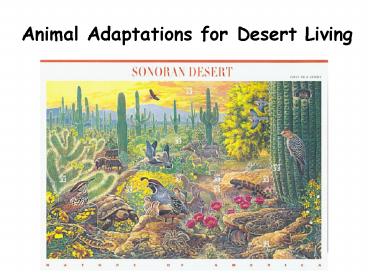Animal Adaptations for Desert Living - PowerPoint PPT Presentation
1 / 30
Title:
Animal Adaptations for Desert Living
Description:
Challenges of Desert Living. Heat Balance = Hs Hc Hr He. Hc = Heat exchange due to conduction ... 500kg camel: 1% 10-20% body water loss is lethal. ... – PowerPoint PPT presentation
Number of Views:4850
Avg rating:5.0/5.0
Title: Animal Adaptations for Desert Living
1
Animal Adaptations for Desert Living
2
Challenges of Desert Living
- High temperatures ? keeping cool
- Low humidity ? conserving water
3
Heat Balance Hs ? Hc ? Hr ? He
Hs Heat stored in body
Hc Heat exchange due to conduction convection
conduction transfer between bodies in
contact convection acceleration of conduction by
motion
Hr Heat exchange due to radiation
radiation electromagnetic emission or absorption
He Heat exchange due to evaporation
evaporation exchange due to heat changing water
from liquid to vapor
4
Keeping Cool 1. Heat Avoidance
Behavior javelina stay in shady area during
midday heat rodents, tarantulas,
scorpions active at night
Reduced Hc and Hr
5
Relative Heat Load (kcal)
Body Mass (kg)
Heat load is greater for small animals. Being
nocturnal pays big if youre small!
6
Exception which proves the rule
Antelope ground squirrel Out at midday, returns
repeatedly to burrow where it lays body flat
against cool ground. Sparse fur on belly promotes
conduction.
Increased Hc
7
Figure 41.8
8
Keeping Cool
2. Long Appendages
Desert ant and beetle have long, thin legs, Which
lifts body higher from the ground.
Stenocara a beetle Namib Desert
Cataglyphis the desert ant Saharan Desert
Reduced Hc
9
Keeping Cool
3. Passive Radiators
- Jackrabbit
- large ears act as passive radiator flat ears
have high SV - blood close to surface, and lots of surface
Increased Hr (meaning animal increases radiation)
10
Arizona cottontail rabbit species has bigger ears
than cool-weather species.
Sylvilagus auduboni
Sylvilagus floridanus
11
Mule deer, a desert-adapted deer, also has big
ears.
White-tailed deer for comparison
Herd of mule deer
12
Also kit fox of American Southwest.
13
Knut Schmidt-Nielsen
fennec fox lives in still-hotter Saharan desert
14
Keeping Cool
4. Evaporative Cooling
- Sweating (mammals, one insect)
- Panting (mammals)
- Gular fluttering (birds)
Increased He and Hc via convection
15
Evaporative Cooling
Heat lost when liquid H2O is converted to
vapor. Works best when humidity is low!
swamp cooler
16
Evaporative Cooling Is Best for Large Animals
body water loss per hour at 35oC 0.1kg K-rat
12 70kg human 2.5 500kg camel 1
10-20 body water loss is lethal.
Small animals cannot survive heat stress by
sweating or panting alone
17
The exception which proves the rule.
Diceroprocta apache cicadas emerge as adults in
hottest time of summer (mid-June). Males sing
midday. Singing can raise thorax T by 12oC.
18
HOW? They sweat! Sweating cicadas lose 20-35
of body water every hour.
Cicadas can afford H2O loss because they feed on
xylem fluid of plants. Xylem fluid is mostly
H2O.
19
Honeybee spit An evaporative cooling trick
- Hot bee regurgitates drop of nectar ( sugary
water) while flying. - Some H20 in the bubble evaporates.
- Remainder of drop re-ingested.
Increased He
20
Keeping Cool 5. Countercurrent Heat Exchange
Thomsons Gazelle escape behavior can generate
copious heat brain must work effectively premium
on keeping brain cool
21
Selective Brain Cooling (SBC) In Gazelles
Veins Carry deoxygenated blood towards
heart Arteries Carry oxygenated blood away from
heart
22
Venous blood cooled in nose, via panting.
Warm arterial blood flows through cool venous
blood, resulting in countercurrent heat exchange.
Cool arterial blood goes to brain.
Increased He and Hc by convection
23
Brain Temperature (oC)
Body Temperature (oC)
Brain T increases more slowly than body T.
24
- Challenges of Desert Living
- High temperatures ? keeping cool
- Low humidity ? conserving water
25
Conserving Water
1. Estivation Behavior
spade-foot toad Most of the year, estivates
underground covered in mucus until monsoon rains
estivation a state of reduced metabolism that
functions to survive drought and heat stress
26
Conserving Water
2. Reduced Water Loss in Excretion
Kangaroo Rat All of the water they need to
survive is metabolized from the dry seeds they
eat.
27
Knut Schmidt-Nielsen 1960s Studied Merriams
Kangaroo Rat in Santa Rita Mountains near
Tucson. Suspected that excretion was key.
28
Nitrogen Excretion and Water Loss
29
Nitrogen Excretion and Water Loss
K-rats might excrete uric acid BUT DONT!
30
K-rat urine is 3-4xs more concentrated than our
own urine! HOW?
- What Kidneys Do
- maintain ion concentration
- maintain water volume
- remove metabolic end products (like urea)
- remove foreign substances































